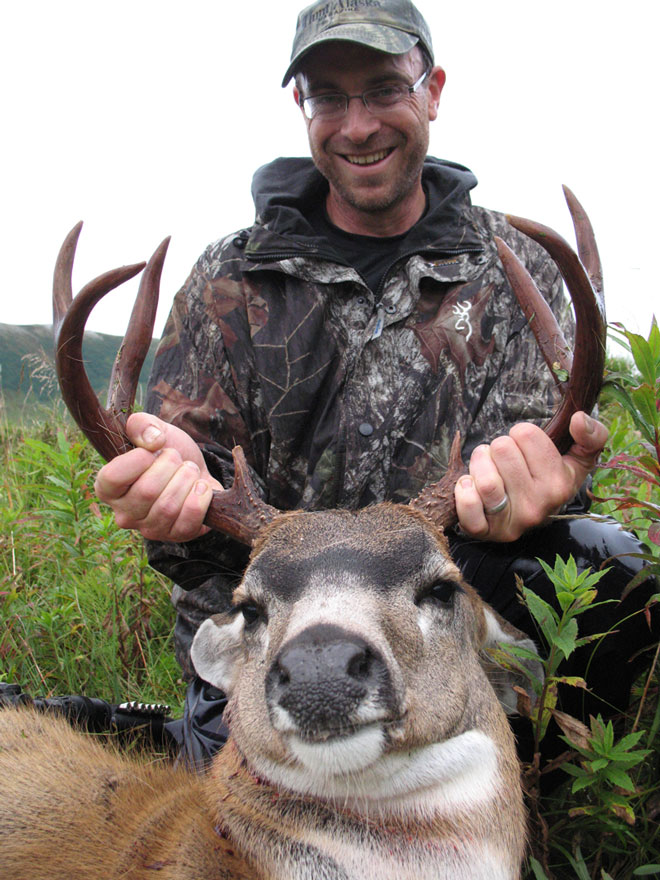
By Marcus Weiner
Often overlooked in Alaska due to the presence of glamour animals such as moose, brown bear, Dall sheep, caribou and mountain goats, the Sitka blacktail deer offers a wide range of hunters a solid chance at taking a large game animal, and in many cases, it’s the perfect first large game animal for a young hunter.
The species is available throughout Kodiak and adjacent islands, on the lands within Prince William Sound and in Yakutat—and in all three places the populations were established from deer indigenous to Southeast. Sitka blacktail are native to southeast Alaska from Juneau to Prince of Wales Island.
Most Sitka blacktails range from 80- to 120 pounds, but big specimens, particularly from Kodiak and Prince of Wales islands, can reach 175 pounds. The biggest factors determining deer size are predators, weather, food and genetics. Harsh winters, particularly in succession, can put deer populations in a downward turn that leads to years of sub-par hunting. On the other side of the coin, when winter-kill is reduced, then deer populations begin to increase and hunting stays good for years. Deer are most active at dawn and dusk and tend to bed down and stay out of sight during daylight hours. They are browsers and can be found in the summer feeding on herbaceous vegetation and the green leaves of shrubs. During winter, they eat evergreen forbs like bunchberry and trailing bramble, as well as woody browse. During periods of deep snow, deer target woody browse, which includes blueberry, yellow cedar, hemlock and arboreal lichens. Deer rarely eat grass but will graze on emerging beach sedges in the spring.
Does begin reproducing at age two and continue producing fawns until 10- or 12 years of age. Typically, does have twins. Breeding season is November and fawns are born in late spring, after a 6- to 7-month gestation period. Predators include black and brown bears, wolves and human
Early-season hunting is concentrated in the alpine. At that time, bachelor groups ofbucks assemble and stay in the high country. As the season progresses into the rut, animals migrate to lower elevations and will respond to a doe bleat. During late November and December, heavy snow sometimes concentrates deer at low elevations and can make it easier to harvest an animal. Typical hunting strategy includes finding a location where glassing a wide area is possible, and when animals are spotted, commencing the stalk.They can be hard to ambush in thick cover, so it pays to stay still and find an animal on the move.
Rifle hunters targeting blacktails don’t need to utilize the large-caliber rifles often necessary for other Alaska hunts—another reason hunting blacktails is a good way to introduce younger hunters to the field. In general, anything in the .243 to .280 range is good for these deer, with a .30-06 on the larger end of the spectrum.
Sitka blacktails are found in GMUs 1-6 and require a harvest ticket to hunt. Season dates and bag limits vary. In general, seasons range from mid-August to the end of December with bag limits of 2- to 6 deer per year. It is the most often pursued big-game animal in southeast Alaska, with average harvests of 12,334 deer over a 20-year span from 1987 to 2007. For recommendations on transporters and guides, email info@fishalaskamagazine.com.
Learn how to make Blacktail and Egg Noodle Soup.
For more information contact:
Anchorage Office
Alaska Department of Fish and Game
Division of Wildlife Conservation
333 Raspberry Road
Anchorage, AK 99518
(907) 267-2257 phone
(907) 267-2433 fax
Juneau/Douglas Office
Alaska Department of Fish and Game
Division of Wildlife Conservation
P.O. Box 110024
Douglas, AK 99811
(907) 465-4265 phone
(907) 465-4272 fax
